Forget sharks and bears – it’s deer that you should worry about hurting you
Retired public relations professional Bonnie Sashin and her husband had just spent a nice Thanksgiving visit and meal with family at her stepson’s suburban home in the Connecticut city of Fairfield, a charming burg of about 61,000 on Long Island Sound.
By the time they departed the 2022 family gathering, the sun had already set, Sashin recalls.
They cranked up her fairly new Subaru Forester SUV to head to a nearby hotel, where they were staying the night rather than make the two-and-a-half hour drive back to Brookline, Massachusetts, on full stomachs and in full darkness.
“And just as we turned the corner, practically out of the subdivision where my stepson lives … I can feel something hit the car. You know, it’s dark, and I had no idea what could it be. And I was just very alarmed,” Sashin said.
“My husband thought it was some kind of animal, and we of course stopped and fortunately a nice, civic-minded woman in front of us stopped. … She got out of the car. She saw me. She was really nice. She said, ‘Oh, that was a deer.’ And she said, ‘It happens all the time around here.’“
The deadly deer problem
It turns out that deer-vehicle collisions are far more than a southern Connecticut problem. They’re a problem across much of the United States and in other nations. It also turns out Sashin was fortunate not to have been injured or even killed in the incident.
Even people who realize how common deer-vehicle collisions are might be surprised at these startling stats for the United States from this November 2022 study in the journal Cell Biology:
• Around 2.1 million deer-vehicle collisions occur annually.
• The collisions cause more than $10 billion in economic losses annually.
• Each year, they account for some 59,000 human injuries and 440 human deaths.
Kip Adams, chief conservation officer with the National Deer Association, notes that deer are much more deadly to Americans each year than those scary movie and TV threats – sharks, alligators, bears and venomous snakes – combined. (For instance, there were just two deaths in the United States by shark attack in 2023.)
Looks like we should be much more wary of Bambi than of Jaws.
And the United States is not alone in having a deer problem. For instance, a 2023 study from Scotland’s nature agency, NatureScot, estimated that 700 people are injured or killed in deer-vehicle collisions in the United Kingdom annually.
They grapple with the deer problem in such far-flung places as British Columbia, Japan, Australia and Germany, too.
So what can drivers do to protect themselves from unwanted encounters with these herbivores?
When time is not on your side
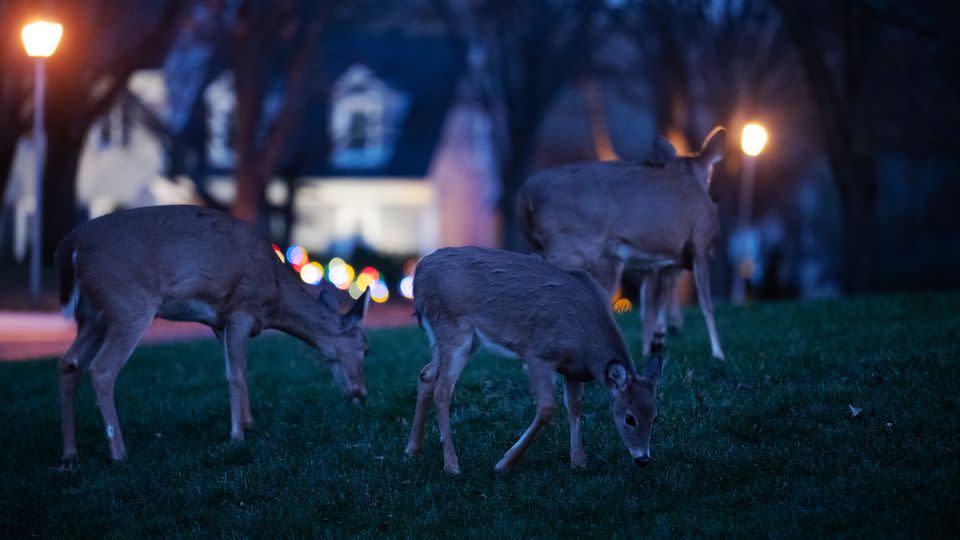
Adams says your best shield against a deer collision isn’t a fancy gadget but knowledge.
“The first step in helping to minimize hitting one is to be aware of when they are most active,” he told CNN Travel in a phone interview. “Two things that play into that. … One is when they’re most active daily and then also when they are most active annually.”
As for the daily factor, sunrise and sunset should be high-alert times for drivers, Adams said. Why is that?
“Deer are what’s known as crepuscular – crepuscular means most active at dawn and dusk,” Adams said. “The way their eyes are built, they can do the best job avoiding predators and collecting what they need when they move in low-light situations – that being dusk and that being dawn.”
But “that’s not our peak vision time. So those two things together – more activity at a time when we can’t see as good – really play into increased deer-vehicle collisions at those times,” Adams said.
Chad Stewart, a deer, elk and moose management specialist with the Michigan Department of Natural Resources, concurs.
“I would say the hour on either side of both sunrise and sunset are the greatest times when a collision can occur,” he said in an email interview with CNN Travel. “This is partly due to deer’s activity around that time, but also because of heavy traffic patterns during those hours.”
But collisions can occur anytime around the clock, Adams cautions.
Keep seasons in mind
Collisions can also happen any time of year – after all, deer don’t hibernate, Adams points out. But two times of year are typically more high risk.
Adams said the first one is spring. That’s fawning time, and “deer are way more active around roads,” he said.
“When a doe is having her fawn, the does become extremely territorial of those areas. … What happens is deer get spread out a lot more on the landscape, which means that they’re more apt to, you know, be near a road.”
But autumn is the season most fraught with danger, Adams said, “and the majority of that occurs in November. During that time, deer greatly increase their daily movement patterns,” he said, especially the bucks.
Research from State Farm insurance company also highlights November as the most likely month of the year to have a collision with an animal.
Where to be on high alert
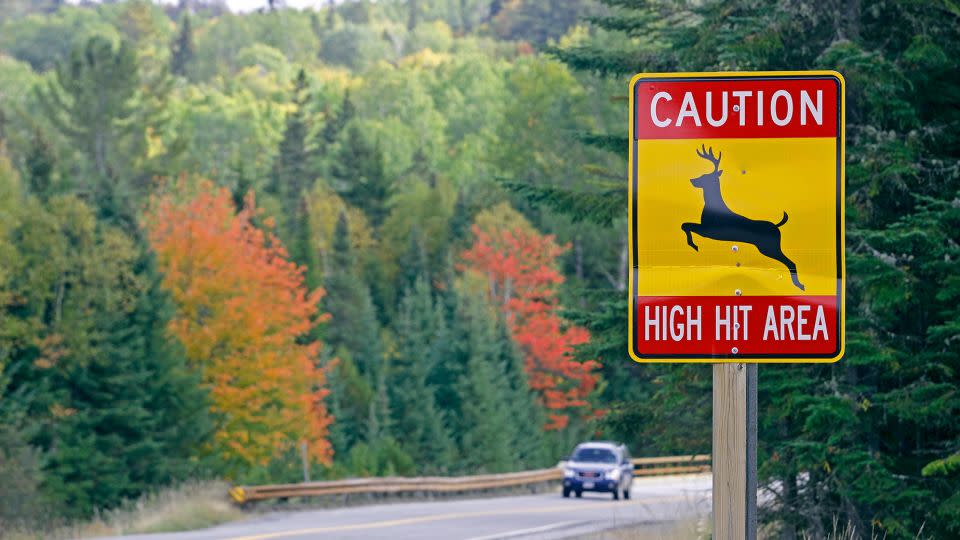
As Bonnie Sashin’s collision in a Connecticut suburb illustrates, you don’t have to be out in wilderness to collide with a deer.
“Typically, suburban areas can hold higher densities of deer, and with more miles driven by vehicles occurring in these areas compared to rural areas, total number of collisions tends to be highest in these areas,” Stewart cautioned.
“But with that being said, any place has the potential for a collision. Especially where habitat transitions occur (e.g. forest to field), which are commonly used locations for deer.”
Adams said be on extra guard where the woods come out close to the road, where “we have very little opportunity of seeing those deer prior to them being in front of a vehicle.”
The suburbs are also a big problem, he said, “because it’s extremely difficult to manage deer populations in those areas. We can’t go in there in most cases and hunt like we do in more rural areas.”
States with the biggest deer problems
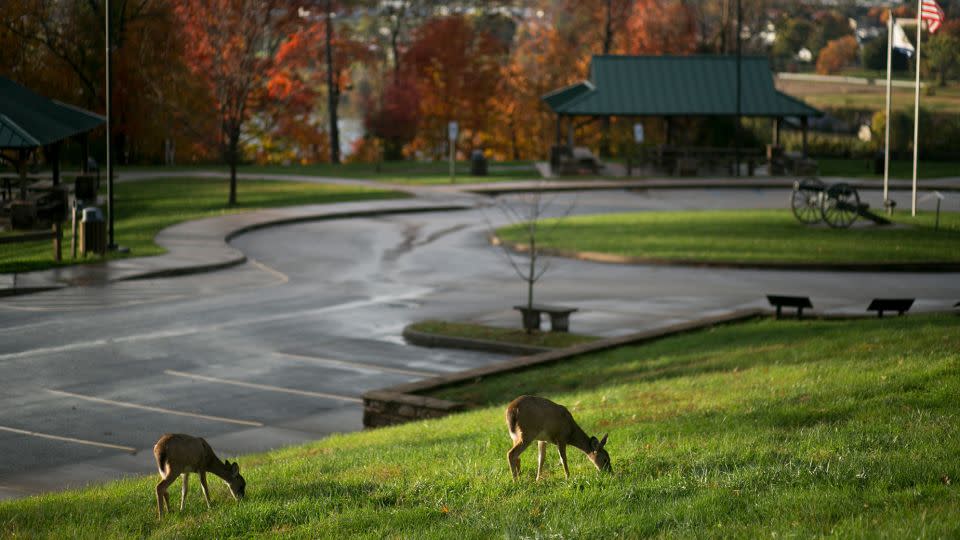
Some US states have a bigger problem with deer-vehicle collisions than others.
State Farm compiles annual statistics assessing the risk in each state. While the insurance company’s statistics cover all animal-vehicle collisions, deer account for the majority of them.
Seventeen states are considered “high risk” for an animal-vehicle collision, according to the latest State Farm report for 2023-24.
Topping the list is West Virginia, where drivers have a 1 in 38 annual risk of being in an animal-involved claim, State Farm says.
That’s not surprising to Adams. The Mountain State is filled with forests, has a high deer population and lacks much in the way of dense urban areas.
“They have a lot of winding roads through wooded areas which further reduces the visibility. A lot of factors play together there that definitely put West Virginia at the top,” Adams said.
Rounding out the top 5 states are:
No. 2: Montana (1 in 53 chance)
No. 3: Pennsylvania (1 in 59 chance)
No. 4: Michigan (1 in 60 chance)
No. 5: Wisconsin (1 in 60 chance)
Your best bets to avoid colliding with an animal: Nevada, where State Farm says the chance is just 1 in 770, and Hawaii (1 in 710 chance).
Defensive driving
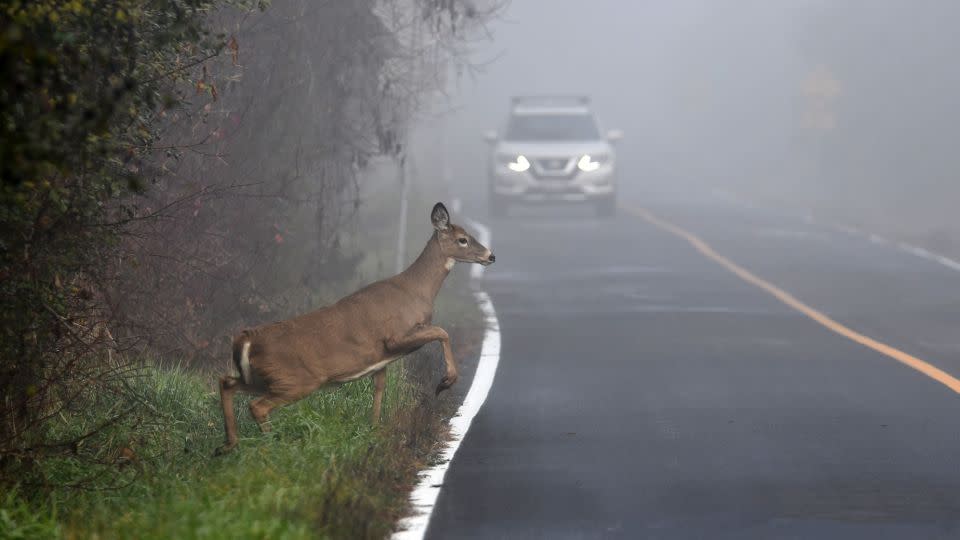
Once you’re better aware of when and where the collision risk is highest, then it’s time to put driving strategies into place.
“Basic safe driving principles apply to reduce your chance at a collision. First and foremost, avoid distracted driving,” Stewart said. Also, slow down in areas known to have high deer numbers so you can “have better reaction should one jump out in front of your vehicle.”
Adams said use your high beams whenever possible in deer territory – but don’t blind oncoming traffic.
Stewart’s not sold on gadget remedies.
“Using things like car mounted whistles are not proven to reduce or prevent collisions from occurring, so saving your money and not falling into a false sense of security with these items is advisable.”
However, do make good use of your car horn, advises the National Deer Association in this YouTube video.
Some other tips from the Michigan State Police:
• Deer typically follow one another in single file, so if you see one deer, there are likely more nearby.
• Look for the reflection of headlights in a deer’s eyes and deer silhouettes on the shoulder of the road.
• Scan the roadside while driving, especially around wooded lots, fencerows, field edges and areas near water.
Do. Not. Swerve.
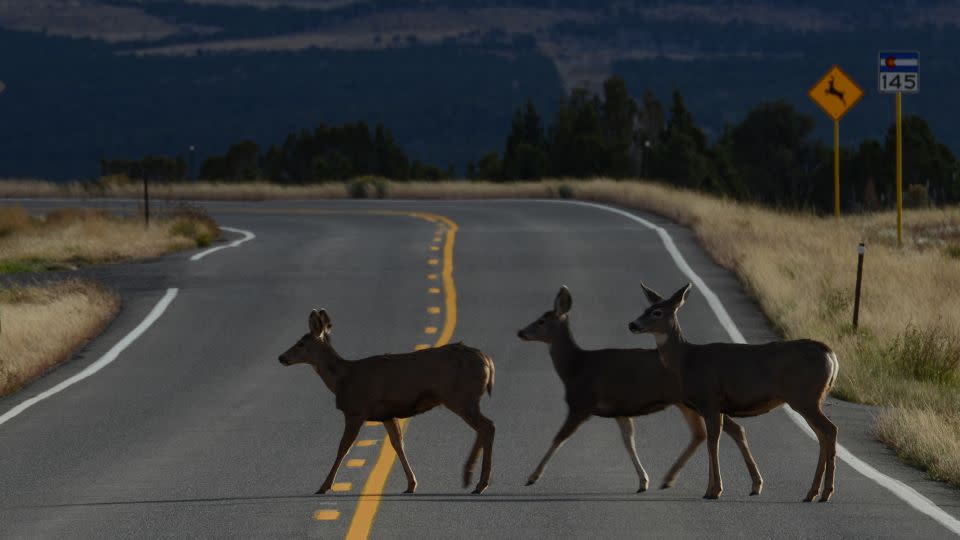
Unfortunately, some drivers despite all their caution are going to have to make a split-second decision – and fight a natural impulse – when there’s a deer ahead in the road.
“We have a campaign in Michigan called ‘Don’t veer for deer.’ The reason this phrase is used is because while nobody wants to hit a deer, there can be far worse consequences by swerving to avoid a deer and hitting something else, like a telephone pole or another car,” Stewart said.
“Sometimes, collisions with deer simply can’t be avoided. But the important thing is to not make it worse for you or somebody else by abruptly and erratically leaving your lane.”
Adams dispenses the same advice with a fatherly touch.
“I have a 17-year-old daughter. I talk to her about this all the time. Try to avoid the deer but do not swerve because your chances of having a bad accident are much higher,” he said.
“It’s way better to hit a deer with the front of your car going straight where that car is built to withstand an impact than it is to swerve and go off the road” and possibly hit a tree or another vehicle, Adams said.
The problem with pets and feeding
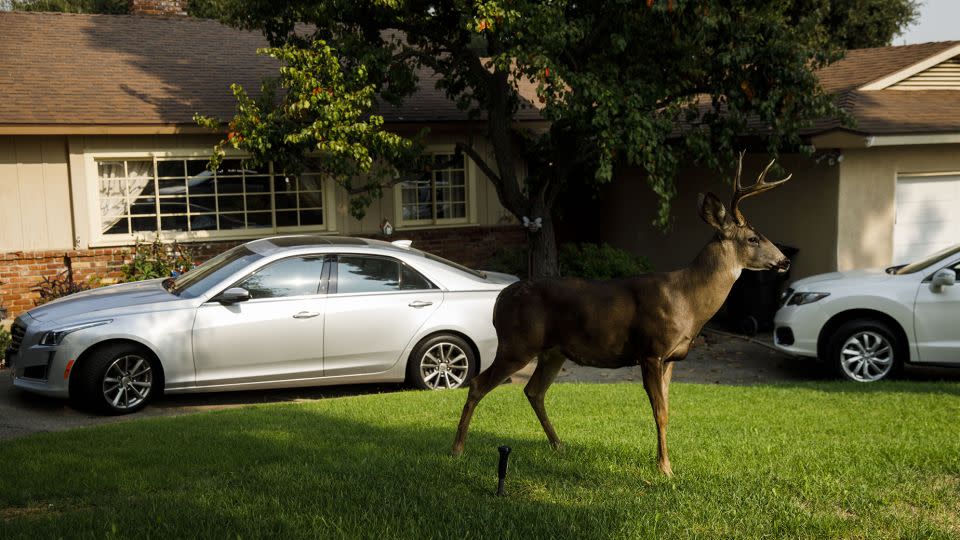
Collisions account for the vast majority of interactions that result in injuries or deaths to people, Adams said, but they aren’t the only ways people can be hurt by these generally docile grazers.
Though incidents are very rare, he said deer that have been raised in captivity and have lost their fear of humans can end up hurting the hands that fed them.
“You can find accounts where … somebody got attacked by a deer, like literally attacked. In almost every case, that was a captive animal that had been hand reared.”
Several years ago, a Colorado woman was cited for illegally raising a young deer that attacked and gored one of her neighbors, according to state wildlife officials.
In 2023, a Florida man’s pet deer was euthanized on the scene by officials after the animal attacked one of his neighbors.
Also in 2023, a man on vacation in Greece approached too closely to a deer for a selfie. The deer rammed him and broke some of his ribs.
The Florida Fish and Wildlife Conservation Commission warns people not to feed deer and to treat them with the respect wild creatures deserve.
Hunting accidents
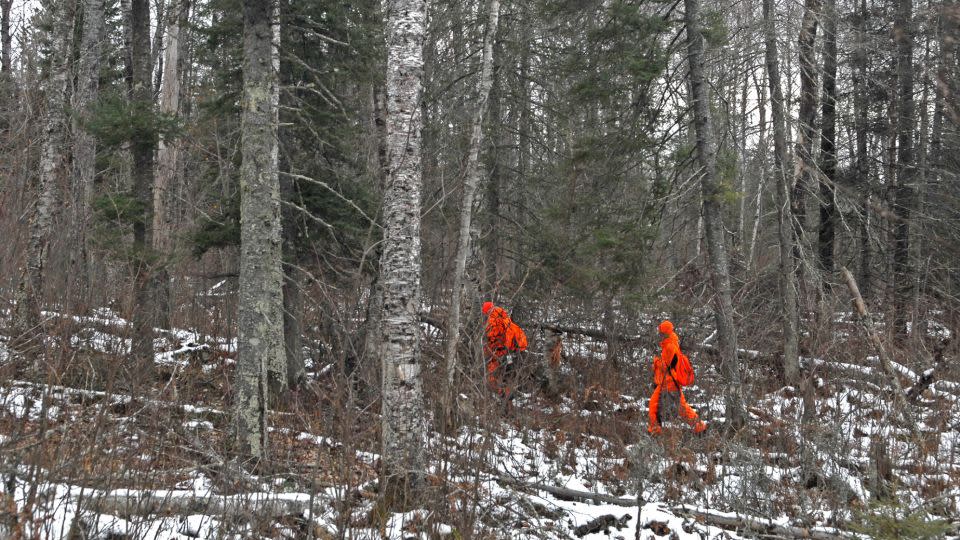
Hunting is the other time where human-deer interactions can go wrong.
In 2019, an experienced Arkansas hunter was found severely injured in the woods, his body riddled with antler puncture wounds from a deer he had shot but had not killed. He later died. Experts say hunters should wait 15 to 30 minutes before approaching a shot deer to make sure it is dead.
However, the biggest danger in deer hunting is other people, Adams said.
“Hunting is very safe, and it has gotten way safer over the past couple of decades with hunter safety programs, but accidents still do happen. And it’s very clear that the most dangerous person in the woods to you, if you’re hunting, is the person you walked in the woods with.”
Again, awareness is key, Adams said.
“I have a family camp in northern Pennsylvania. We have a lot of friends and family that hunt that we share our land with. … If we are going out as a group to hunt deer, bear, whatever … I have a little safety talk and tell everybody, ‘Hey, let’s be careful today.’ “
‘I came away lucky’
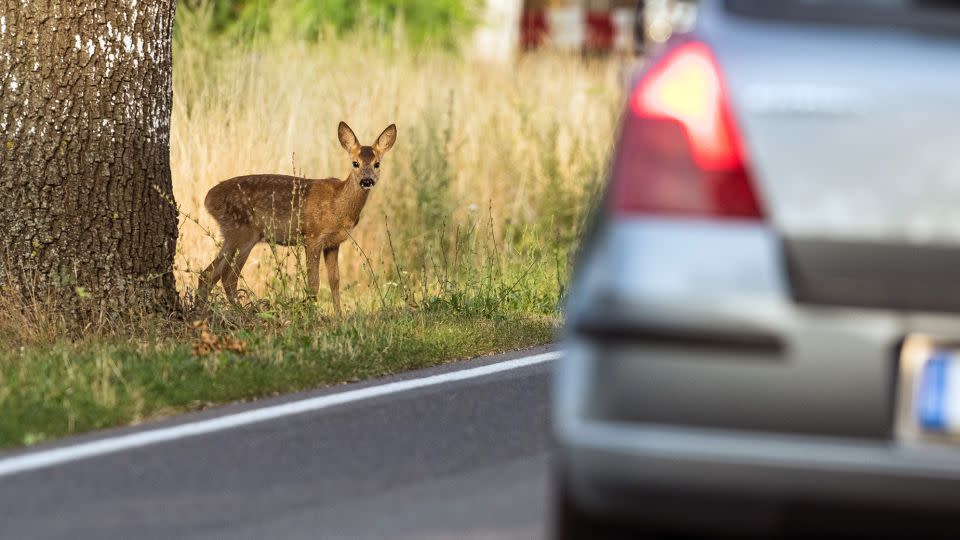
Bonnie Sashin’s Thanksgiving night collision with a deer happened in a flash. But the repercussions took a while to sort out. The Good Samaritan who stopped in front of her was quite helpful, she said.
“First thing she said to me – which was the best piece of advice for us because no one was hurt – was call the police … because you’re gonna want a record for your insurance company.”
Sashin said she later learned about a friend who collided with a deer and didn’t call the police right away – and the adjuster gave her a hard time.
The front fender of Sashin’s new car was bashed in, but she and her husband were able to drive her SUV back to Massachusetts, where they learned the vehicle could be repaired vs. being totaled.
“I went in to my body shop where I know the guy, his name is Paul. … He said, ‘Bonnie, get in line. You know how many cars I have that have been hit by deer in the last week?’ ” There were five or six ahead of hers, he told her.
“The pain in the butt part is that you gotta wait a long time these days with a body shop. … It’s very hard to get parts.” She had to wait until February to get her SUV repaired.
Sashin and her husband continue to drive to family trips in the Northeast, but they try to be off the road before dark these days.
Despite everything, she’s grateful they weren’t hurt or the vehicle totaled. “I came away lucky.”
For more CNN news and newsletters create an account at CNN.com

